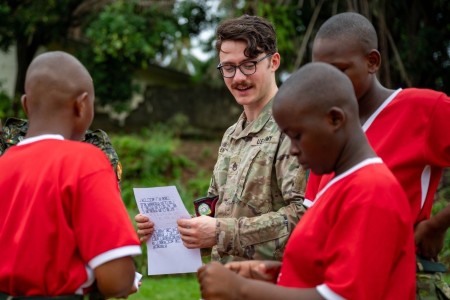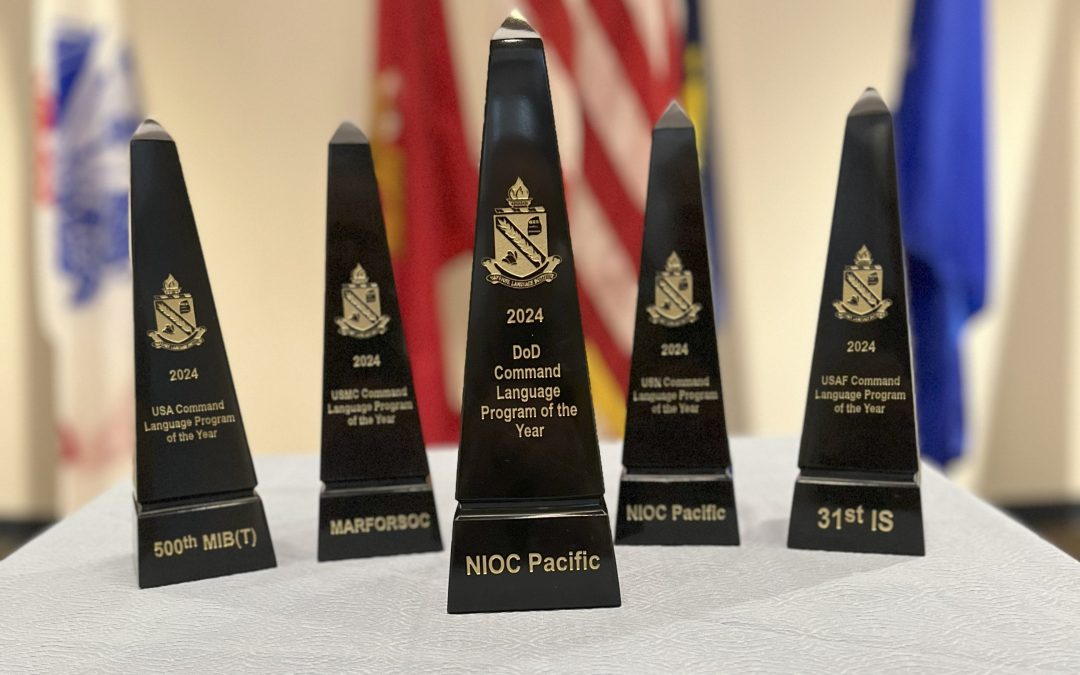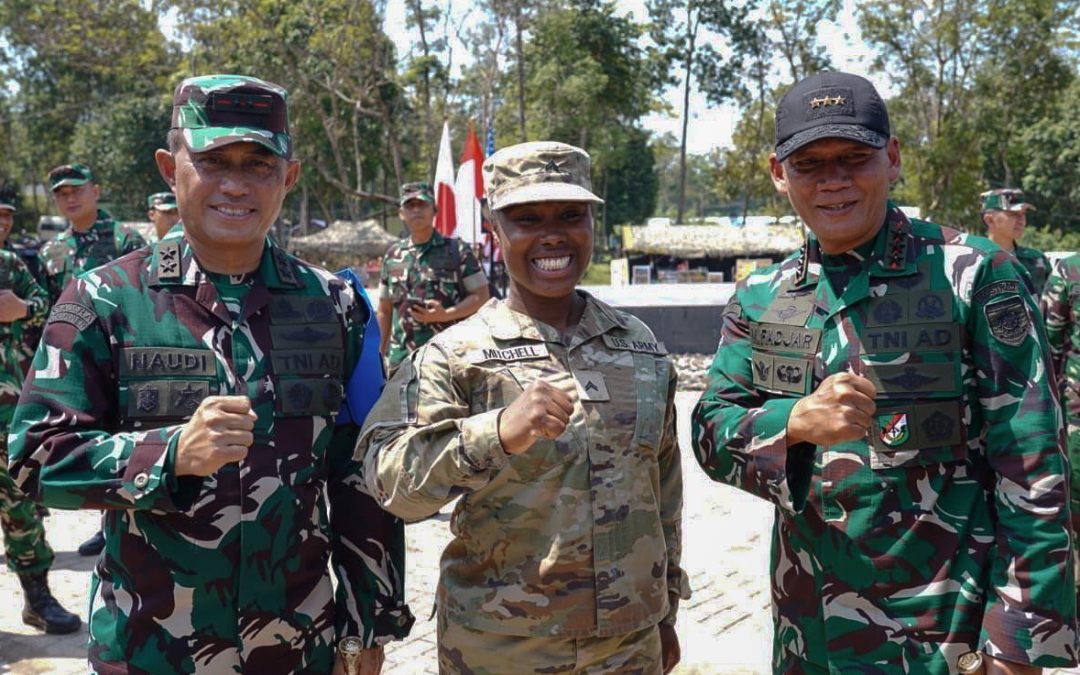By Patrick Bray
DLIFLC Public Affairs
Editor’s note: This article is a feature from the Foreign Area Officer program’s monthly officer professional development series at DLIFLC.

Kathleen Walsh, associate professor of national security affairs at the U.S. Naval War College China Maritime Studies Institute, presented lectures on China at the Defense Language Institute Foreign Language Center July 21. Walsh spoke about two current topics of interest in international affairs in her presentation titled “21st Century China: U.S. partner, rival or adversary?” to students studying Mandarin Chinese and to Foreign Area Officers in language training at the institute. (Photo by Patrick Bray, DLIFLC Public Affairs)
MONTEREY, Calif. – Kathleen Walsh, associate professor of national security affairs at the U.S. Naval War College China Maritime Studies Institute, presented lectures on China at the Defense Language Institute Foreign Language Center July 21.
Walsh spoke about two current topics of interest in international affairs in her presentation titled “21st Century China: U.S. partner, rival or adversary?” to students studying Mandarin Chinese and to Foreign Area Officers in language training at the institute.
“Western scholars don’t truly understand China. They try to predict where China might fail, but they are not doing a very good job of explaining why China has succeeded despite all the challenges and obstacles,” said Walsh.
The first topic covered the South China Sea and a recent ruling from the Permanent Court of Arbitration at The Hague, Netherlands. On July 12, the court ruled in favor of the Philippines in the 2013 case Republic of Philippines v. People’s Republic of China in the Spratly Islands dispute.
The Spratly Islands are a cluster of more than 100 reefs, sandbanks and islets in the South China Sea. The Philippines, Vietnam, Malaysia, Brunei, China and Taiwan all lay claim to some or all of the islands. The court’s ruling states that China’s claim of having historic rights to the islands is invalid under international law because China has artificially built up islands of interest, while technically no feature in the Spratly Islands meats the definition of the United Nations Convention on the Law of the Sea. Additionally, it is not clear if China lays claim to only land territory or all the territorial waters surrounding the islands.
Either way, China has stated that it will not abide by the court ruling.

The Spratly Islands are a cluster of more than 100 reefs, sandbanks and islets in the South China Sea. The Philippines, Vietnam, Malaysia, Brunei, China and Taiwan all lay claim to some or all of the islands. (Image courtesy of the CIA World Factbook)
“I think this issue is going to be a turning point in China-U.S. relations and global affairs. It will determine if China is a partner, rival or adversary,” said Walsh.
Under the U.N. definition an island must be self-sufficient, with an ability to sustain human life, including the producing fresh water. However, China claims that each islet is in fact an island and contains its own exclusive economic zone, or EEZ. This is where the South China Sea dispute is today.
Walsh further explained the significance of the Spratly’s. An EEZ is 200 nautical miles from the coast under U.N. law. If each reef or islet scattered throughout the sea were to theoretically have an EEZ that belonged to China, no ships could transit the South China Sea without Chinese permission placing Southeast Asian economies and the world economy under Chinese control, according to Walsh. Modern Chinese maps already show the Spratly’s as part of China.
China also interprets an EEZ to mean no presence of foreign military assets within the zone. The U.S. Navy and Air Force, along with other forces in the region, frequently enter the South China Sea which currently holds a “freedom of navigation” status.

Ships and submarines from the Republic of Singapore Navy and U.S. Navy gather in formation during the underway phase of Cooperation Afloat Readiness and Training (CARAT) Singapore 2015 in South China Sea July 21, 2015. (U.S. Navy photo by Mass Communication Specialist 2nd Class Joe Bishop/Released)
“Why are the Chinese doing this? Are they going to continue and what does this mean?” Walsh asked the students in an open ended question referring back to her opening statement that scholars do not fully understand China.
The second topic covered Chinese globalization through China’s Silk Road Economic Belt and the 21st-century Maritime Silk Road, which is better known as the One Belt, One Road initiative.
In this initiative China is establishing infrastructure across Central Asia, which closely follows the historic Silk Road, to better establish trade with Europe. China is also building in Africa as part of the maritime Silk Road, which passes through the South China Sea and transits the Indian Ocean to Africa.
China is expanding its economic zones outside of its own borders as an alternative to the U.S. dominated international order. According to Walsh, this is an effort to marginalize the U.S. by looking west and uniting Eurasia and Africa under the Chinese model of globalization. The initiative is going particularly well in Africa as China is building infrastructure that the African countries otherwise could not afford, especially improvements to ports, highways and railroads.
Both China and the U.S. view these actions differently. Where the U.S. may perceive some things China does as a threat, China sees itself as only modernizing under its own model of globalization.
“The Chinese are succeeding. They believe their model is the best,” said Walsh, which led her to ask another open ended question. “Is communism dead in China?”
Socialism with Chinese characteristics was best described by Deng Xiaoping, the Chinese leader after Mao Zedong, in 1989 when he said, “You are in a room with two doors. One door says politics; one door says economics. If you open the economic door, you can go the full distance to basically whatever you want. If you open the political door, you are going to run right into walls, and eventually you are going to run into the State.”

Kathleen Walsh, associate professor of national security affairs at the U.S. Naval War College China Maritime Studies Institute, presented lectures on China at the Defense Language Institute Foreign Language Center July 21. Walsh spoke about two current topics of interest in international affairs in her presentation titled “21st Century China: U.S. partner, rival or adversary?” to students studying Mandarin Chinese and to Foreign Area Officers in language training at the institute. (Photo by Patrick Bray, DLIFLC Public Affairs)
Today, Xi Jinping, President of the People’s Republic of China, is putting ideology (Maoism/Marxism) back on the table.
“We thought the Chinese were becoming more like us – predictable if you will – but now it is going the other way,” said Walsh. “Is Xi the new China? To be determined – we’ll have to wait and see whether China is partner, rival or adversary.”
Walsh spoke as part of the FAO program’s monthly officer professional development, which is a critical part of FAO training at DLIFLC. The monthly program is as an essential addition to the biannual Joint Foreign Area Officer Course Phase I, usually held in January and June.
FAOs, who come from the four branches of the U.S. military, are regionally focused and are considered experts on political-military issues. Once their FAO training is completed, they are expected to serve as defense attachés, security cooperation officers and political-military planners worldwide.
DLIFLC provides resident instruction in 23 languages at the Presidio of Monterey, California, with the capacity to instruct another 65 languages in Washington, D.C., graduating more than 200,000 linguists since 1941.
In addition, multiple language training detachments exists at sites in the U.S., Europe, Hawaii and Korea spanning all the U.S. geographic combatant commands in support of the total force.




